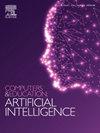Artificial intelligence in higher education: Modelling students’ motivation for continuous use of ChatGPT based on a modified self-determination theory
Q1 Social Sciences
Computers and Education Artificial Intelligence
Pub Date : 2024-12-13
DOI:10.1016/j.caeai.2024.100346
引用次数: 0
Abstract
The purpose of this study was to investigate the determinants of higher education students' motivation towards continuous usage of ChatGPT for English language learning, based on a modified Self-Determination Theory (SDT). A quantitative approach hinged on a cross-sectional survey design was adopted, and an online questionnaire used to collect data from 324 students studying English as Foreign Language (EFL) and English as a Second Language (ESL). The data were analyzed using a Partial Least Squares-Structural Equation Modelling (PLS-SEM) technique. This study established that initial ChatGPT usage determined students' perceived autonomy, competence, relatedness and challenges in ChatGPT usage. In addition, a novel finding was that, both autonomy and relatedness predicted students' competence in using ChatGPT to learn. Further, determinants of students' motivation for continuous usage of ChatGPT were autonomy and relatedness. Lastly, the study through Important-Performance Map Analysis (IPMA), established autonomy as the most important as well as the highest performing factor determining students' motivation for continuous usage of ChatGPT. The validated SDT model explained a large total variance of 70.8% in students’ motivation for continuous use of ChatGPT. Based on the results, recommendations were made for both theory as well as policy and practice towards ChatGPT usage in higher education.
求助全文
约1分钟内获得全文
求助全文
来源期刊

Computers and Education Artificial Intelligence
Social Sciences-Education
CiteScore
16.80
自引率
0.00%
发文量
66
审稿时长
50 days
 求助内容:
求助内容: 应助结果提醒方式:
应助结果提醒方式:


